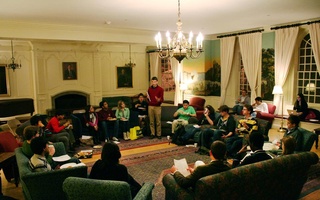In the dead of night on April 9, 1969, Michael Kazin ’70, styling himself as a modern Martin Luther, walked up to Loeb House, the home of then-University President Nathan M. Pusey ’28, and tacked a list of demands on his door as 300 fellow protesters looked on. At the top of their list was the expulsion of the Reserve Officers’ Training Corps.
The Harvard chapter of Students for a Democratic Society, led by Kazin, had gathered earlier that night in Lowell Lecture Hall to debate the takeover of a University building, the culmination of months-long protests against the Vietnam War and the University’s relationship with the military. By the following afternoon, the situation would reach a head as hundreds of protesters forced their way into University Hall, throwing out top administrators in protest of the University’s continued recognition of the program designed to train students for active military service.
In the intervening decades since ROTC left campus, the organization’s presence on campus has remained low-profile and symbolic of the University’s often tense relationship with the military.
But in March, Harvard made a break with the antagonism of recent years and moved to officially recognize Navy ROTC. As University President Drew G. Faust signed an agreement with Navy Secretary Ray E. Mabus in a stately room of Loeb House, Harvard’s history with ROTC appeared to have come full circle as the corps was welcomed back feet from where the leftists of the 1960s had officially demanded its expulsion.
But outside Loeb a new generation of protesters had gathered. Unlike their counterparts 40 years earlier, they are opposed to the presence of ROTC on campus because of what they see as the military’s discriminatory policies toward trans identified individuals rather than the categorical opposition to the military that characterized the dissidents of the ’60s.
Over the last half century, changing political circumstances have altered Harvard’s relationship with the armed forces as anti-militarism has become unacceptable and any criticism of the military have focused on specific policies. Within this context, the Harvard community’s relationship to the military has morphed from contentious opposition during the ’60s, to conservative reaction during the ’70s and ’80s, to one of relative indifference and apathy today.
A PATRIOTIC DECADE
When Capt. Paul E. Mawn USNR (Ret.) ’63, the current president of Advocates for Harvard ROTC, entered Harvard in 1959, the presence of the military on campus was a fact of life.
Harvard’s relationship with the military stretches back to the American Revolution, and as late as World War II the University was actively hosting a Naval officer’s school. In the 1950s, the military still commanded a great deal of respect and a relatively positive profile on campus, and, as Mawn put it, membership in ROTC was as unremarkable as membership in the Harvard band.
The financial incentives associated with the program also explained a portion of its popularity on campus.
For Malcolm T. Hill Jr. ’59, the president of the Harvard ROTC Alumni Fund, the existence of the NROTC Holloway Plan—a merit scholarship program that provided free room and board in return for military service—attracted him to ROTC. As Hill explained, it was less competitive to get into Harvard than to receive a Holloway grant when he applied to Harvard.
For many, the continued existence of the draft—as America moved from combat in Korea to Vietnam—furthered interest in ROTC as joining the program was a way to put off service and ensure a higher position after leaving school.
“I facetiously say that I dodged the draft by going into active duty,” Mawn says.
And these incentives reached across campus—in Mawn’s class, 100 of 1200 eligible students participated in one of the three branches of ROTC.
But the acceptance of ROTC went beyond practical concerns. The memory of World War II was still fresh in the minds of students, and many, like Mawn, were children of veterans. Then, the military was more than a career, and ROTC was more than a scholarship or activity. At that time, the military was something to be respected rather than reviled.
Read more in News
Facing Crime on CampusRecommended Articles
-
ROTC? ROFL!To recognize ROTC would not be to violate the University’s policy against discrimination.
-
Keep ROTC Out of RangePromising to reinstate ROTC simply to pressure a repeal of DADT is short-sighted
-
 ROTC Faces Uphill Battle
ROTC Faces Uphill Battle -
Activists Say Military's Policy Remains BiasedThe Harvard Trans Task Force (TTF) is circulating an online petition protesting the possible return of the Reserve Officers’ Training Corps before the military allows trans-identified and intersex individuals to openly serve in the military.
-
 Harvard Political Union Debates ROTC
Harvard Political Union Debates ROTC -
 In Rapprochement, University Hosts Welcome Reception For Veterans
In Rapprochement, University Hosts Welcome Reception For Veterans













